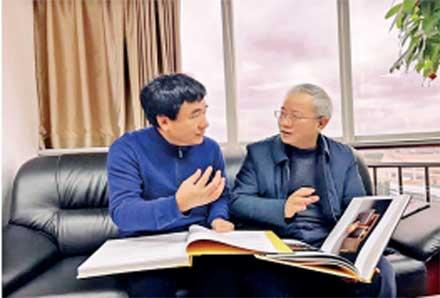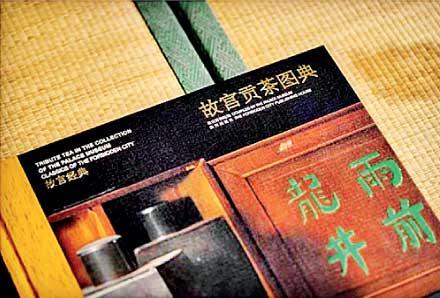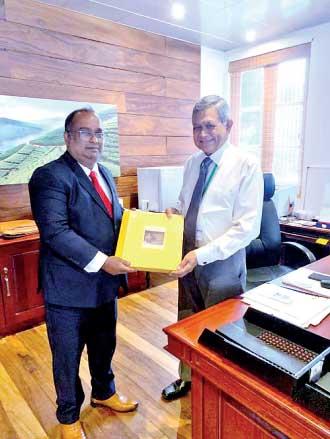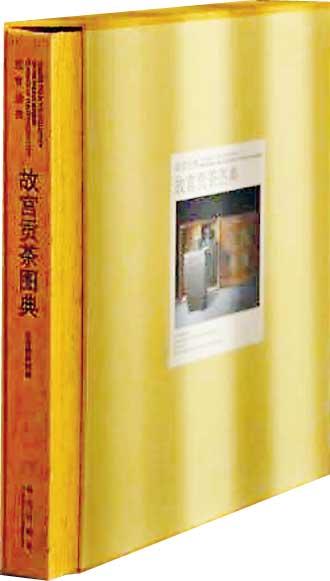06 Jun 2023 - {{hitsCtrl.values.hits}}

Our initiative was honored to be recognised by Mr. Wang Yamin, former executive vice president of the Palace Museum, and Ms. Chen Lihua, former vice president of the Palace Museum, as well as the support of Yan Yong, director of the Palace Department of the Palace Museum, GuoFuxiang, deputy director, researcher Wan Xiufeng and other experts of the Palace Museum

Tribute Tea in the Collection of the Palace Museum -- secrets from royal tribute tea
 |
| A copy of the book is been handed over to the Tea Board Chairman. |
 |
| "Tribute Tea in the Collection of the Palace Museum" |
‘Tribute Tea in the Collection of the Palace Museum’ is the first physical atlas of palace tribute tea in the history of Chinese tea.
Speaking of the Forbidden City, you will think of the imperial power struggle, Royal treasures and historical dynasties. Some people described it this way: from Wu Gate to ShenwuGate, every corner of the Forbidden City seems to be telling the story of the Chinese nation, carrying China’s millennium history and witnessing the inheritance of Chinese civilization.
Hardly realizing, in the heavy and thick basement door of the Forbidden City, hundreds of national treasures and royal old tea are stored on the shelf, and few people pay attention to them. These old teas have been stored for hundreds of years, witnessing the rise and fall of the dynasty, prosperity and vicissitudes. These old tea are tribute tea. Among the profound culture contained in the Forbidden City, tribute tea culture is unique.
What is tribute tea? Tribute tea has been given a heavy mission since its birth. It is a tribute from the land to the royal family. Tribute tea is tea for the emperor. The emperor likes to drink tea, so the local officials will devote themselves to finding good tea for the emperor and planting precious tea. Thousands of rare and good teas are paid tribute every year, so the tribute tea of the Forbidden City has also become the aspiration of every tea lover.
The book of Tribute Tea in the Collection of the Palace Museum was published, and the secret of royal tribute tea, which has been sleeping for a hundred years, was revealed. How particular was the emperor about drinking tea? What does the royal tea party look like? Where does the tea of the royal court come from? What does tribute tea look like? Are those tea gardens that claim to be centennial tribute tea producing areas true or false? What is the history of tribute tea...All these mysteries, maybe this book can give you the answer.
There are pictures and codes in the book, with both pictures and texts. It vividly shows the totem of tribute tea in the Forbidden City in front of readers.
Serving the emerging tea market
I have been engaged in tea international trade, production R & D and operation management for many years. I have visited many tea producing regions and countries in the world, such as Kenya, Sri Lanka, India, Vietnam and other countries. I have established tea trade exchanges with many African countries, Russia and American countries. I have also encountered relevant government departments and business elites in the tea industry.
On the one hand, the other party holds respect for China as a large tea country with a long history. On the other hand, it is also confused about many Chinese tea varieties. He doesn’t know how to distinguish and judge. We have encountered many similar puzzles in the domestic traditional tea market, including the operation and service of the emerging tea market.
China is recognised as the birthplace of tea bushes in the world. There are many tea producing areas and thousands of local tea varieties and tea products with their own characteristics. However, few people can tell what a special variety of tea and finished tea from a certain place should look like? What exactly should it taste like?
Based on the processing techniques, tea can be divided into green tea, white tea, yellow tea, oolong tea, black tea and jasmine tea. When did the process start? For certain traditional tea, how was it made in the past? What are the aroma, taste and the unique features of the tea made by the authentic process.
Due to the lack and inaccuracy of documents and records, there are many uncertain problems in the historical development process of China’s tea industry.
This makes it difficult for our tea producers and consumers- even many researchers in tea science and tea culture- to form a unified standard and consensus on the characteristics of traditional tea varieties and traditional technology. This has resulted in a large number of industry employees who do not know the tea that has been inherited for hundreds or even thousands of years should be like, what varieties and processing technology should be used, what aroma and taste should it be.
Without these traditional standards and consensus, there is much distorted information leading to short-term interests in the market, which has a negative impact on the majority of tea practitioners which makes them distressing but irreparable behaviour.
For example, dig out the traditional old varieties of tea that have grown for several generations in the local soil and water and plant some varieties popular in the market from other provinces. For example, changing the traditional production process, eliminating the traditional processes that may be time-consuming and labour-consuming, and one-sided pursuing the good-looking and high output of finished tea. In these tosses that do not meet the traditional requirements and scientific methods, the shape, taste, aroma and even taste of local excellent traditional varieties are lost, Even some excellent traditional tea varieties that have been inherited for hundreds of years have disappeared forever, and the excellent traditional crafts are no longer remembered. These circumstances are distressing.
I always hope to have a more authoritative book that can help our tea industry practitioners and consumers understand the history, culture and real traditional crafts of China’s excellent tea categories. My close friend Mr. Li Fei and I have conducted many serious discussions regarding this. Mr. Li Fei has been engaged in tea evaluation and the construction and production practice of ecological manor tea for many years and has a deep research on traditional tea and tea culture.
Our initiative was honored to be recognised by Mr. Wang Yamin, former executive vice president of the Palace Museum, and Ms. Chen Lihua, former vice president of the Palace Museum, as well as the support of Yan Yong, director of the Palace Department of the Palace Museum, GuoFuxiang, deputy director, researcher Wan Xiufeng and other experts of the Palace Museum.
Thanks to the joint efforts of all experts in the study of culture and cultural relics of the Forbidden City, Mr. Liu Xu, Mr. Chen Xingwu, Ms. Xu Qingzi, Mr. Wang Xiaojie and other tea industry experts invited by Mr. Li Fei and I and this book was completed. This is undoubtedly a grand ceremony of contemporary Chinese tea industry and tea culture. I am personally honoured and grateful to participate in it.
Tribute Tea in the Collection of the Palace Museum explores and studies the Qing Dynasty tribute tea, tea sets and other cultural relics collected in the Imperial Palace Museum, systematically excavating and studying the best Chinese traditional tea varieties that have become palace tribute tea in history, showing the original appearance of tribute tea and packaging, and listing the palace archives records of corresponding tea products and the contents of retrieved local documents. Domestic excellent tea evaluation experts were invited to conduct a professional quality evaluation of tribute tea, summarizing and generalizing the historical status of tea industry and tea culture in the provinces where the product is located.
It is believed that this book will play a good role in correcting the source and enlightening the latecomers for the inheritance and development of Chinese traditional tea culture and Chinese tea industry. Its value will be recognized by more and more friends who love Chinese traditional tea culture and care about and engage in Chinese tea industry.
Zhang Chaobin
10 Jan 2025 51 minute ago
10 Jan 2025 1 hours ago
10 Jan 2025 2 hours ago
10 Jan 2025 3 hours ago
10 Jan 2025 3 hours ago